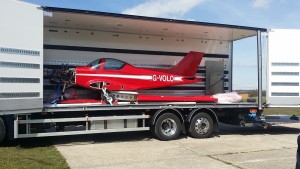Wednesday 4th May.
Posted: 06/05/2016 12:34
Wednesday 4th. An establishing anticyclone replaced the W'lies of Tuesday with a moderate SSE'ly, early Cumulus gradually disappearing as the air dried out to leave blue thermals, these giving climbs to a maximum of 5,300' asl. However, the broken nature of the lift and the strong wind at flying height made cross country flying something of a struggle, Lindsay Mclane taking 4:16 to visit Guisborough and Burn before returning to Sutton, a task distance of 181 km. Nick Gaunt took his LS7 as far as Carlton before deciding to stay more local in his flight of 3;13, while Steve Thompson climbed in wave near Stillington to around 7,000' asl in his Discus and used the height to get to Rufforth and back to Sutton after 2:10, the same time being achieved by Colin Troise in his DG600. With course members, visitors, members and 4 First Flight pupils all eager to fly, the launch point remained busy all day as 47 launches were flown off runway 20, 38 of the launches provided flights of over 30 minutes, with 17 over an hour. Course member Jane Tocher continued to amass flying time with 1:02 and then 1:31 in K21 JVZ with instructor Ian Willows , her fellow course member Peter Whitcombe making a valiant effort to keep up with 1:15. Mike Smith and David Hill shared a flight of 1:10 in the DG1000, it being pleasing to have David on the flying log again after his recent operation. Phil Morgan and Carol Pike, visiting from Shalbourne GC, added to their rapidly accumulating weekly total of hours by adding another 1:42 in their Janus on a day when 12 private owners flew as did all the available club gliders. Thermal activity continued until around 1830 hrs the day providing the sight of all 4 club 2 seaters soaring the same thermal aroung 1800 hrs. The other interest of a good flying day was provided by the arrival of a light twin which brought the pilot of the Pioneer 300 which had suffered damage while landing at Sutton a week or so ago. The purpose of the visit was to supervise the de-rigging and removal of the aircraft to a repair facility and the means by which this was achieved is shown in the following photo provided by Jon Hart.

Have hangar will travel would seem to be an appropriate caption. After the departure of his damaged aircraft the pilot returned to his light twin and taxied up runway 02 to prepare for take off, only to get bogged down in a soft patch at the northern end. However, the combined efforts of members, visitors and course members were sufficient to extricate the aircraft and allow it and its crew to depart. I somehow feel we may not see them and their aircraft again.
This blog describes a snippet of life at the Yorkshire Gliding Club. Why not take a flight and try it yourself, or we can teach you to fly as a full club member.




